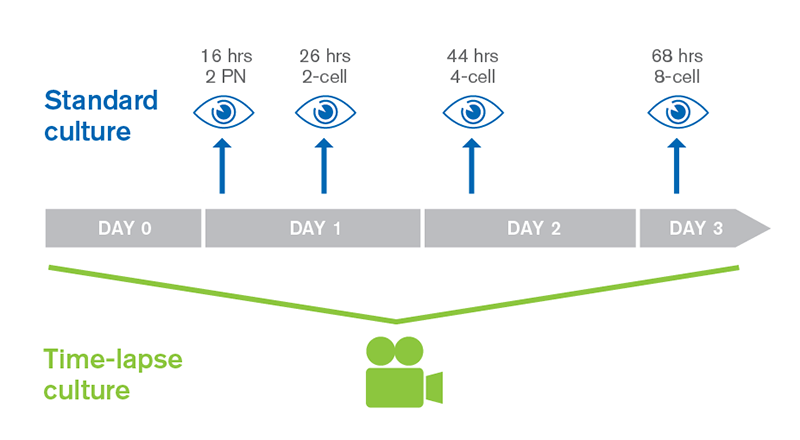Some people consider the appearance of time-lapse technology in the field of IVF a huge step forward while others dismiss it as “a hype”. Personally I am convinced about the value of using time-lapse in IVF and to me the benefits are obvious. In this blog post I will highlight and discuss some of the benefits with time-lapse.
Criticised technology with high potential
Time-lapse technology has unfortunately been criticised for the lack of proper prospective clinical studies confirming the positive correlation between morpho-kinetic based algorithms and clinical outcome. However, time-lapse is far more than just kinetic algorithms. It is also an optimised culture system with minimised culture-induced stress that allows you to evaluate embryo development on a level that is not possible with traditional techniques. Access to time-lapse gives you the opportunity to evaluate, or “catch”, several morphological events that are not seen with conventional scoring methods due to the dynamics of embryo morphology.
Time-lapse helps you overcome the catch 22 in IVF
The observational dilemma, or catch 22, in IVF is that you want as much information as possible about the developing embryos to be able to select the best to transfer, or deselect those with a lower implantation potential. On the other hand you want to avoid disturbing the embryos by taking them out from the incubator for evaluation. Access to time-lapse technology in the IVF lab allows you to leave the embryos in the incubator while a camera continuously takes images of the whole embryo development. These images are put together into a film, which gives unlimited possibilities to evaluate embryos without any handling stress.
Selecting the right embryo
Improved selection, or de-selection, of embryos by the use of time-lapse is achieved by a combination of morphological and morpho-kinetic parameters. Important parameters such as the dynamic morphology of embryo development (including multinucleation and fragmentation), certain critical abnormal cleavage patterns and morpho-kinetics can only be seen or evaluated by the use of time-lapse technology.
As an example, about 20% of embryos do not follow a normal cleave pattern, i.e. goes through direct cleavage. When performing traditional morphological embryo assessment these events are most often missed. Since multinucleated embryos, fragmented embryos and embryos with abnormal cleavage patterns have a lower implantation potential or result in a higher pregnancy loss, the inability to detect these highly dynamic events will affect the clinical outcome of an IVF treatment.
Proven clinical benefits of time-lapse
Numerous articles supporting the clinical benefits of using time-lapse in IVF have been published over the last couple of years including the following;
(1) reduced pregnancy loss,
(2) improved implantation rate and
(3) shorter time to pregnancy
1. Rubio et al (2014);Fertil Steril 102 (5):1287-1294 e1285. 2. Meseguer et al (2012); Fertil Steril 98 (6):1481-1489 e1410. 3. Kovacs et al (2013);Fertil Steril 2013;100(3):S90. 4. Siristatidis (2015); J Assist Reprod Genet. 5. Barrie et al (2013); Fertil Steril 100 (3):S248. 6. Vitrolife metaanalysis of Kahraman et al (2013); J Reprod Stem Cell Biotechnol;3:55-61, Kovacs et al (2013) and Rubio et al (2014.)
Download white paper to learn more
Dr. Markus Montag, known to most of you as an exceptionally experienced scientist in the field of IVF, has written a white paper where he discusses the clinically proven results with time-lapse, as well as how time-lapse can improve the workflow in the lab and facilitate communication. Click to download the paper and enjoy the reading!
Topics: Time-lapse, Embryo culture & transfer
Written by Dr. Christer Silversand
Christer “Silver” Silversand is a Senior Scientist at Vitrolife. Silver is strongly committed to improving the implantation rate and the outcome of IVF treatments. He is dedicated to quality control and culture conditions and you can often hear him lecturing passionately about the importance of minimising intracellular stress during culture of human gametes and embryos.

